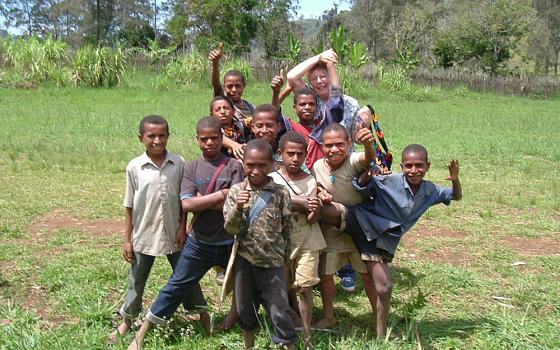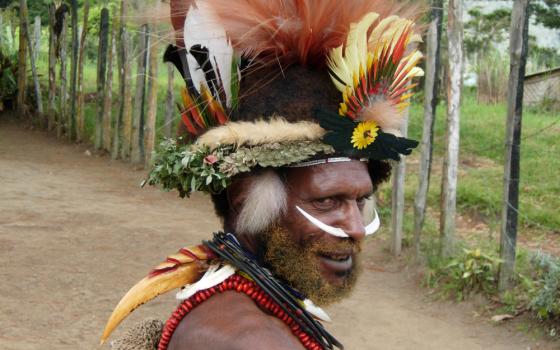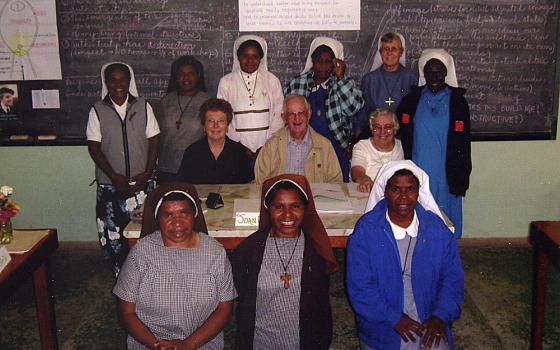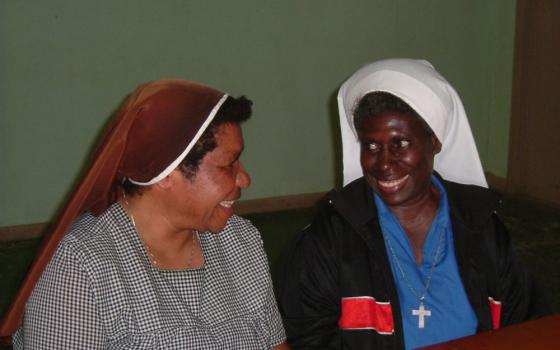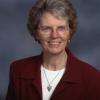"Let there be peace on Earth, and let it begin with me." This is the firm belief of Sr. Joan Marie Brandner, a Sister of the Presentation of the Blessed Virgin Mary of Aberdeen, South Dakota.
Brandner has traveled to many places in the world to bring this message to others through Personality and Human Relationships, a program founded in 1970 by Frenchman Andre Rochais (1921-1990).
As a teacher, Rochais was haunted by the question: Why is it that I teach and teach and yet nothing seems to change in my students? He gradually discovered the answer by observing human behavior in persons from many cultures and beliefs.
His observations revealed that we not only share a universal humanity, but each of us has an innate drive toward actualization or wholeness. Thus, during the 1970s, he developed a program to assist in the process of self-actualization called Personality and Human Relationships, PRH. The program, designed to promote well-being and personal autonomy, is now delivered in 30 countries. I became acquainted with this program when I worked in Zambia in the 1980s and experienced its positive personal growth impact on people involved in it.
Brandner was licensed as a PRH professional educator in 1989. She learned about the process when engaged in vocation/formation ministry for her congregation. She sees it as an important transformational tool for healing relationships and development of individual potential that leads to service of others and to the betterment of the world at large.
GSR: Joan, you have been a PHR professional for many years now. How have you experienced it as transformational for yourself and others?
Brandner: The program is both educational and therapeutic. It promotes the well-being and growth of individuals and communities. I am convinced that inner personal growth is essential for the work of building communities of peace and justice in our world. It also fits into the U.N. Sustainable Development Goals that promote the well-being of people.
One memory I have from a trip to Papua New Guinea shows this need of transformation of personal and cultural behaviors very dramatically.
We had finished a week's session with Sr. Rita and her high school students. They were ready to return to the only secondary school in the Mendi area of the Southern Highlands. They climbed into their vehicle, knowing the trip would take most of the morning, a long, slow, rough ride over pot-holed roads caused by daily driving and torrential rains. Plus, they would not be surprised if they had to change flat tires a few times. Hard, sharp rocks exposed by the rain were the usual fare.
Two hours later, to our dismay, we saw them returning, [and we were] curious to know what had happened. They had come across a deep trench 4 feet wide and 6 feet deep, hand-dug by one tribe in retaliation for something done to them by another group. The trench would block all movement for who knows how long.
Unfortunately, a row or two of sweet potatoes planted beyond an agreed-upon border can set off a feud lasting for months. Ninety percent of land in PNG is legally uncharted, so lawlessness is a way of life.
Can such a contentious type of arbitration ever change? Fortunately, PRH educators work with group after group in these highlands tribes, and families are slowly finding new and constructive ways for dealing with their conflicts. The highlands are beginning to see fewer feuds than before.
Technology has also helped the process. I will never forget seeing a man walking barefoot in the jungle, dressed only in a loincloth. I was enthralled with his beautiful feather headdress. He was carrying a machete in one hand and a smartphone in the other. I learned that he was talking to a chief a mountain range away. Modern technology is breaking down barriers among tribes by providing a vehicle for more positive negotiation and reconciliation.
What is involved in becoming a PRH educator, and how has it continued to transform your own life?
When I first received my license to teach the program, I did group workshops and individual coaching in the United States as well as doing my own inner work. Eventually, I was invited to become a trainer of new educators and to assist them in discerning a path to taking on the role. This discernment is a long and usually grueling process of inner work to recognize the role as a special call and to determine if there is really a passion for it. My own discernment evolved over nine years.
An image that gives a picture of my personal transformation is the parable about the differences between houses built on sand and those built on rock. I started out in the sand. My rock-like existence didn't happen overnight, but was strengthened gradually. I was plagued with unresolved exaggerated issues with parental figures. In these encounters, I felt like a hurt little child in an adult body. I even physically recoiled in the face of authority figures. Gradually, that child inside healed, grew up, and I now function as an adult. I can 'stand on inner ground,' free and full of confidence. I have new energy and potential, no longer second-guessing myself. I don't live with regrets about past actions, but lean into the future instead. It has given me a new zest in life.
That was a great story of growth. Thanks for sharing. What was your first teaching experience as a PHR educator?
It was at a Benedictine monastery in South Dakota with 17 participants from South Dakota, Minnesota and Indiana — women, men, married, single and religious. Three priests wanted to strengthen their support group; a group of sisters on their way to the Black Hills for vacation decided to stop for a retreat; another sister was finishing a sabbatical and wanted a time for transition; and a young woman was discerning her vocation.
The beauty and quiet of the monastery setting was really perfect. When the week was over, each participant said they were leaving the time of inner work and interaction with others with a fresh understanding of themselves and new tools to help them continue growing.
After working for a time in the United States, I was invited to branch out to regions of the world where English was a second language. My most challenging times were two visits to Papua New Guinea. Pidgin English, a combination of English, German and local dialects, is the national language. I had to listen very carefully, and the speakers had to slow down and often repeat what they were saying several times before I got it. These new educators also had challenges. They had to translate what they had learned into local dialects, which are 800 in number. This takes a deep and passionate sense of mission.
I am curious to understand how the emotional language and content of the program can be translated through another language. How do you do it?
That is a great question, and I am not really sure how it happens. I have just seen it happen. A lot of care goes into placing educators in different countries. The program content was originally in French, then translated to English and into Spanish. But for other languages, translators are not always easy to find. PNG was lucky. A New Zealander missionary, Br. Barry, has a degree in linguistics. He learned to skillfully simplify the English for the pidgin speakers. As you may guess, sometimes stirring controversy breaks out among the students as they struggle to translate the academic and emotional content accurately in the many different dialects.
What kind of venue and students did you have in Papua New Guinea?
Being in Papua New Guinea was such a unique experience. The Mendi sessions were held in diocesan buildings with tin roofs, so the afternoon's predictable downpours created a great banging overhead. To accommodate the storms, we scheduled quiet time and writing. There are about 10 to 12 local sisters in training to become educators. Some have already received their licenses and are becoming PRH professionals. Two others have recently taken over leadership of the PNG teams.
What was the most important thing they learned? You said they moved forward personally and professionally.
Some of the educators are already teachers who teach the basic programs. But through special five-day workshops, 'Becoming a PRH Professional,' they are learning how to run PRH business, prepare materials, interpret and execute session plans and professional methods in making presentations. They also have learned skills in personal accompaniment and counseling.
On the personal level, they shared how their experiences of coming from strong tribal structures created difficulties for them in living community with those not from their tribes. PRH helped them learn skills to set aside these biases, putting into practice the 'universal humanity concept.' Sometimes there have been failures. One entire community disbanded, unable to work through their differences.
What are some of the topics covered in the program?
The program is both educational and therapeutic to help individuals work through personal issues. Some of the areas we address are: life in the workplace, discovering a couple bond (for married couples), helping children become themselves, commitment to inner health, making good decisions, listening to body messages and many others. The topics are taught in a particular sequence designed by Andre Rochais, and each workshop is about 24 hours in length.
How is the international PHR program organized, and does the program adapt to changes in the world?
Every four years, a global assembly of educators is held in different regions of the world. I attended in France, Spain, Canada, Thailand and countries in Latin America, Asia Pacific.
An average number of participants is about 250. We are divided into language groups of French, Spanish and English. Each language group engages in the same materials, and large group sessions have simultaneous translation. There is also opportunity for personal accompaniment. The usual process of reflection questions is used to stimulate self-reflection, self-awareness and discernment.
The international team of president and councils, including directors of formation and culture, oversee the world and are responsible for planning the international gatherings. They invite consultation from all the various country teams.
The program is built on adaptation and adjustment. Andre Rochais was fond of saying, 'Reality is our teacher.' It began as one workshop and now has 35 workshops, each addressing different elements of human development. There are also short modules relating to particular topics. We learn about the latest developments in pedagogy for teaching adults so that we keep up on what is happening in the world around us.
How are e-communications used for follow-up?
Besides the international team using it for the two-year planning of the international meetings, our U.S. team meets by Skype for professional in-service training sessions. I also work with a sole PRH educator, Zofia in Australia, to give her support and training.
When you look back over the years you have been involved with the program, what have been the most significant changes? What do you see for the future?
I have seen the program develop from a French-only program to a worldwide reality. Because of Andre's vision of flexibility, adaptability and evolution, further development is always evolving. Over and over, I have witnessed it filling a need in people globally. It is also a source of connection beyond cultures and belief systems. Even though a small movement, it fulfills what the world yearns for: deeper levels of communion and peace.
Every four years, we witness more members joining, and so we believe strongly in its future. The next gathering in 2020 will be in Argentina.
[Joyce Meyer is a member of the Sisters of the Presentation of the Blessed Virgin Mary and is GSR's liaison to women religious outside of the United States.]
